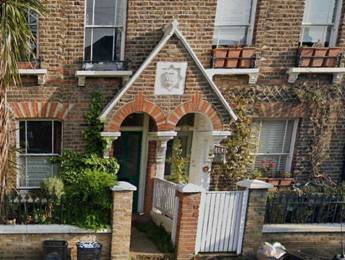
Major
ERNEST HENRY JENKINS
Royal Engineers
(formerly 1869902 Clerk of Works Quartermaster Sergeant)
by
Lieutenant
Colonel Edward De Santis
Ó 2019.
All Rights Reserved.
1. INTRODUCTION
The principal references
used in the preparation of this narrative were from a number of sources, but the
primary source was Major Jenkins’ service papers, which were obtained from the
Army Personnel Centre by his son Donald. Photocopies
of these papers were graciously supplied to the author by Mr. Jenkins.
Other sources used in the research included official registries in the
United Kingdom, a medal roll, a family tree, the London Gazette, Army Lists and
Royal Engineers Lists and Internet web sites.
Major
Jenkins’ service papers contained a lot of information, much of it duplicated
and some of it contradictory. As
with almost all service papers of British officers and other ranks the entries
in the service papers were handwritten, some being nearly illegible.
Many entries were duplicated with different dates showing when promotions
or postings were made. Also, a
number of entries were noted to be out of chronological sequence, making it
difficult to determine what really happened and when.
Despite these shortcomings every effort has been made to accurately
portray the life and military service of Major Jenkins.
All sources are contained in the REFERENCE section at the end of
the narrative and are cited throughout in the ENDNOTES.
Where no citation is provided for a particular even the reader may assume
that the information was extracted from Major Jenkins’ service papers.
Attention of the reader also is directed to work by the author into the life and military service of Brigadier Reginald Edmund Holloway, CBE, R.E. Major Jenkins served under Brigadier Holloway in India in the 1950s. While the author traditionally researches individuals whose medals are in his collection, this is not the case with Major Jenkins. The research was instigated by the fact that Jenkins served with Brigadier Holloway and also because Major Jenkins’ son was kind enough to provide photographs of his father to be included in the Holloway research. Major Jenkins’ medals are described in this narrative, but they are not in the author’s collection. His medal group has been made up from reproductions for display purposes in the author’s collection. Only the 1939-45 Star and Africa Star in the display are original medals as issued for World War 2. The remaining medals in photograph presented in Section 8 of this narrative are reproductions.[1]
Although I refer to Ernest Henry Jenkins as Ernest throughout this narrative it appears that he was known throughout his army career and beyond as “Jerry”. The only person his son ever heard call him Ernie or Ernest was his father. His wife was introduced to him in 1944 as Jerry, which is what she called him for the rest of her life.
Ernest Henry Jenkins was born on the 9th of December 1910, the second child of Stuart Jenkins (1884-1963) and Maud Jenkins (née Birrell) (1879-1950). Prior to Ernest’s birth the Jenkins already had one son, Stuart David Jenkins (1907-1969).
The 1911 Census of England and Wales shows Ernest living with his mother, grandmother and brother at 94 Marne Street in London. Marne Street is located in the Queen’s Park ward of London. The table below shows the entries in the 1911 Census:
|
Name
and Surname |
Relation |
Marital
Status |
Age |
Birthplace |
|
Maud
Jenkins |
Wife |
Married |
32 |
Middlesex,
Paddington |
|
Stuart
Jenkins |
Son |
- |
4 |
Middlesex,
Paddington |
|
Ernest
Jenkins |
Son |
- |
3 |
Middlesex,
Paddington |
|
Mary
Ann Birrell |
Mother |
Widow |
63 |
Oxford
Street, London |
NOTES:

(Photograph courtesy of Google Earth)
Ernest Henry Jenkins was educated at the Droop Street Elementary School and the West Kensington Central School, both located in London.
Both Ernest and his brother Stuart worked in their father’s building firm in London for a number of years but their sister Maud was encouraged to continue her education, which was very unusual in the U.K. in the 1930s. She graduated with a History Degree from King’s College, University of London and married a fellow history graduate by the name of Maurice Bruce. They both had successful careers in higher education. Maud died in Sheffield on the 24th of December 2002, her husband having predeceased her.
Ernest left his father’s business to join the Army in 1932 when the business was struggling to stay afloat during the Great Depression.
3.
PHYSICAL DESCRIPTION
A physical description of Ernest Henry Jenkins on his enlistment in the Army, as taken from his service papers, is as shown below:
|
Age: |
21 years and 4 months |
|
Height: |
5 feet 10¾ inches |
|
Eyes: |
Grey |
|
Complexion: |
Pale |
|
Hair: |
Light Brown |
|
Weight: |
130 pounds |
|
Chest fully expanded: |
35½ inches |
|
Range of chest expansion: |
3 inches |
|
Distinctive marks: |
Mole on left side of stomach |
As with all recruits, his description on enlistment also included his religion; in this case Church of England.
Photographs of Jenkins were made available to the author showing Ernest as he appeared circa 1932, 1938, 1944 and 1963. These photographs are provided in subsequent sections of this narrative. As a 22-year old Sapper upon his enlistment he seems to be clean-shaven and appears to be slender of build, confirming the entries in the table above. By the time he was a Staff Sergeant (1938) his photograph shows him to be of average build with a fair complexion and a receding line of fair to light-brown hair. He appears to have grown a mustache in later years although it is hardly visible in the 1938 and 1963 photographs. He has a dark, toothbrush mustache in the 1944 photograph. In this 1944 photograph he appears much thinner, probably as a result of the hard work and trying experiences he had while serving on Malta. In his later years, after leaving the Army, he wore his hair close-cropped and was bald on the top and front. In the 1963 photograph he appears to be of medium-build and looks like a pipe-smoking man with a pleasant smile.
4. ENLISTMENT AND
TRAINING
Ernest Henry Jenkins was most likely a competent carpenter and joiner when he enlisted in the Royal Engineers on the 4th of May 1932 at the age of 21 years and 4 months.
He was recruited in London by a Sergeant Burrell of the Rifle Brigade and his enlistment was a normal engagement of 4 years with the Colours and 8 years with the Army Reserve. He named as a reference for his enlistment Captain W.R. Birrell, MC, a relative of his mother. More about Captain Birrell will be discussed later in this narrative.
Ernest had been working in his father’s building firm as a young man, probably for about four to six years prior to his enlistment. He was taken on the rolls of the Corps of Royal Engineers as Sapper with his Trade on Enlistment being listed as Carpenter & Joiner. Upon his enlistment he was issued Army Number 1869902. The fact that he was an accomplished carpenter and joiner is borne out by the fact that he was given credit for having attended the Carpenter & Joiners Trade Course and was given a classification of BII in this trade on the day of his enlistment.
When he enlisted he was subjected to the myriad of questions asked of all new recruits when joining the Army. He responded to these questions in the following way:
· He stated that his age was 21
· He was not married
· He was not a member of the Royal Navy, Army, Royal Air Force, Marines, Militia, Territorial Army or Reserve Forces.
· H had never been a member of any of the above named forces.
· He was not an indentured servant.
· He had never been convicted by Civil Power.
· He had never been rejected for enrollment or enlistment in the naval or military forces.
· He was willing to be vaccinated.
· He was willing to enlist in the Royal Engineers.
· He was willing to be trained for mounted duties.
· He was willing to serve for 4 years with the Colours and 8 years in the Army Reserve.
The Oath of Attestation was administered to Jenkins on the 4th of May 1932 and was certified by an Army Recruiting Office Major. On this same date his Certificate of Primary Military Examination was issued at London finding him fit for service in the Royal Engineers. This certificate was issued to a recruit for the Royal Engineers apparently based on their occupation or experience in civil life, their perceived intelligence and the desire of the recruit to receive training and to serve as an engineer soldier. Much importance was placed on the prior experience of the recruit in one of the building trades.
Jenkins received a medical examination on upon his enlistment and was found fit to serve in the Army and in the Royal Engineers. On the date of his enlistment he was issued a Certificate of Medical Examination at London by a Lieutenant Colonel Ware of the Royal Army Medical Corps.
Following his attestation he probably was immediately sent to the School of Military Engineering (SME) at Chatham, Kent where he was assigned to “C” Company of the Royal Engineers Training Battalion (RETB) for his training in the basics of soldiering and military engineering. He arrived at Chatham on the 6th of May 1932. His attestation was approved for service in the Royal Engineers on the 18th of May 1932 by Lieutenant Henry Cave Browne, the Officer Commanding the Training Battalion. By this time Jenkins was already well into his training program.
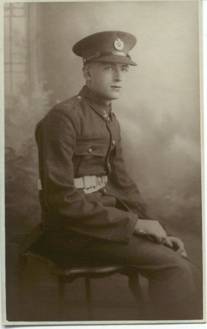
Figure 2. Sapper Ernest
Henry Jenkins, c. 1932.
(Photograph courtesy of his son, Donald S. Jenkins)
5.
ASSIGNMENTS AND CAMPAIGN SERVICE
Home
Service (1933-1936)
By 1933 Jenkins had received both his 2nd Class and 1st Class Certificates of Education and had passed courses in mathematics and map reading.[2]
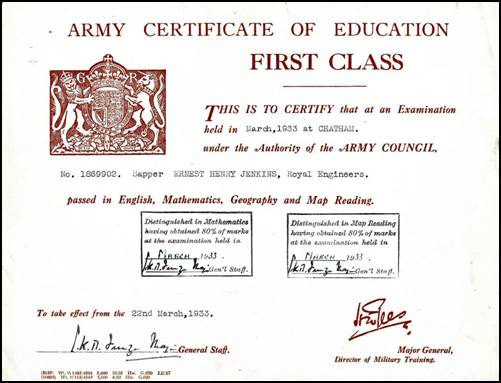
Figure 3.
Jenkins’ First Class Certificate of Education.
(Image courtesy of Donald S. Jenkins)
On the 2nd of May 1933 Sapper Jenkins was posted to the 1st
Anti Aircraft Searchlight Battalion, R.E. (1AA S/L Bn) at Blackdown Barracks in
Surrey and was assigned to “C” Company of that battalion.
Since he was a carpenter by trade he knew nothing of searchlight
operations. Apparently this
assignment was not to his liking and on the 22nd of June 1933 he
requested a transfer out of the Corps of Royal Engineers since there were no
vacancies available for his trade. His
request took the form of a handwritten note to his company commander and is
reproduced below from his service papers.
To
O.C. ‘C’ Coy
1st
A.A. S/L Battn., R.E.
Sir,
I, No. 1869902 Spr. E.H. Jenkins,
solicit the favour of my Officer Commanding to grant me this application for a
transfer to the Royal Army Pay Corps.
I am in possession of an Army First
Class Certificate with a distinction in Maths, and have had experience in
accountancy in civil life.
E.H. Jenkins, Spr. R.E.
22nd
June 1933
Blackdown
It is difficult to know whether this request was based on his dissatisfaction with his duties in the Royal Engineers in general or with the searchlight battalion in particular, or whether he truly preferred the Royal Army Pay Corps base on his “experience in accountancy in civil life.”[3] His request for transfer was not approved and on the 1st of September 1933 he was transferred to “B” Company of the 1st AA S/L Bn.
If he was dissatisfied with his assignment to the anti aircraft battalion this dissatisfaction was not apparent from his job performance. His first Annual Report, rendered by his O.C. on the 15th of September 1933 stated the following:
“A very intelligent Sapper with an inventive mind. Did well in a Sound Locator Course.”[4]
Jenkins Employment Report from the O.C., “B” Company, dated the 18th of October 1933, stated:
“Recently
joined but appears keen and hardworking.”
On the 30th of January 1934 he passed the trade course to become a Search Light Operator and on the 5th of April 1934 he was appointed an Acting Lance Corporal. On the 23rd of April he was transferred back to “C” Company of the battalion.[5]
During this period much emphasis was being placed on the formation of anti-aircraft searchlight units. One might assume that the War Office was considering that aircraft would become major offensives weapons during any future war and that anti-aircraft units would be much needed. Since few individuals were trained to operate search lights in civilian life it would be necessary to choose for training soldiers who were intelligent and had an aptitude for learning new subjects. Jenkins appears to have been one such soldier and he needed to be trained, along with other men of the Royal Engineers, to fill the ranks of these newly-forming units.
During this period of time the Royal Engineers had anti-aircraft (AA) search light battalions that supported the Royal Artillery with anti-aircraft missions. The following is a brief history of the AA organization during Jenkins’ period of service:[6]
The Royal Engineers had developed an extensive anti-aircraft searchlight organization during World War I, but this was quickly reduced after the Armistice. The last remnants of the organization moved to Blackdown Camp at the end of 1920 to form the nucleus of the 1st AA Battalion, R.E., as part of the newly created 1st Air Defence Brigade. Although destined to become the largest Regular unit of the R.E. during the inter-war years, its initial strength was three non-commissioned officers (NCOs) and four sappers under the command of a lieutenant of the Royal Field Artillery. It was another year before it got its first R.E. commanding officer (CO), Lt-Col G.C.E. Elliott, and nearly two years before it received substantial reinforcements.
The main responsibility for AA defence of the United Kingdom was entrusted to the part-time Territorial Army, which developed a large-scale organization under Anti-Aircraft Command before the outbreak of World War 2. The Regulars of 1st Air Defence Brigade (later 1st AA Brigade) were to provide AA cover for field forces, initially for the British Expeditionary Force (BEF) that would go overseas on the outbreak of war. In 1938 it was decided that all coastal and AA searchlights, which operated alongside the Royal Artillery (RA), would become the responsibility of that corps; however, the transfers had not been completed when war was declared in September 1939. A 2nd AA Battalion, R.E., was organised at Blackdown in 1936, but this was disbanded in September 1938 and replaced by the 2nd Searchlight Regiment, RA.
The 1st Anti-Aircraft Battalion was the only Regular Army anti-aircraft searchlight unit on the Royal Engineers establishment at that time. The reader can get a good idea of the work of this unit by reading Searchlights in the Corps of Royal Engineers by Brigadier B. Chichester-Cooke, CBE, TD, DL.[7]
At the time of Jenkins’ assignment to the battalion the unit formed part of the Aldershot Command. The key officers of the battalion were:[8]
Lieutenant Colonel M.F. Grove-White, DSO, OBE, p.s.c. (Commanding)
Lieutenant Colonel G. le Q. Martel, DSO, MC, p.s.c. (Additional)
Captain T. Kimber (Adjutant)
Captain R.P.A.D. Lithgow (Headquarters Wing)
Major K.D. Yearsley, MC (“A” Company)
Major K.I. Gourlay, DSO, MC (“B” Company)
Captain A.J. de Pury (“C” Company)
Returning now to Jenkins’ story, he received his next Annual Report on the 14th of September 1934 from his O.C. As with his previous reports his commander was very complimentary regarding his performance of duty. The report reads as follows:
“Honest,
reliable, hardworking and intelligent. Will
make a good N.C.O. when his powers of command develop more.”
On the 1st of October 1934 Jenkins was transferred back to “B” company of the battalion. The reason for his frequent transfers between “B” and “C” companies is not known. It can only be assumed that the battalion was undergoing changes in personnel and that Jenkins had the training and skills required to fill vacancies that were occurring in the companies.
Based on published information it is known that the 1st Anti-Aircraft Searchlight Battalion took part in an air defence exercise of London while in camp in Essex in mid-1934.[9] These types of exercises were held frequently and in conjunction with the Territorial Army units in the anti-aircraft defence establishment.
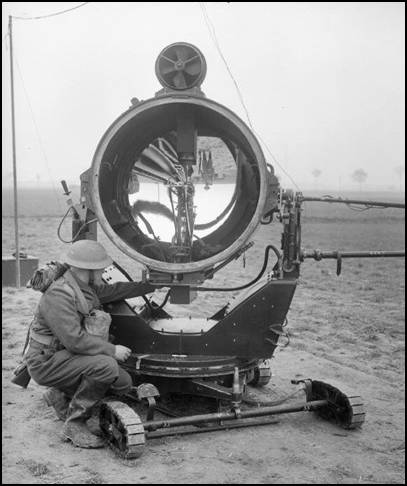
Figure 4. An Anti-Aircraft
Searchlight and Operator of the Royal Engineers.
(Photograph courtesy of Wikiwand)
After completing three years of service Jenkins appears to have decided that the military life was for him. On the 2nd of August 1935 he re-engaged to complete 12 years with the Colours. This was a significant step in his military career, as it indicated that he was going to be in the Army for the long haul. He subsequently was posted to “A” Company of the battalion on the 5th of February 1936. He had now served in each of the battalion’s companies with the exception of the Headquarters Wing.
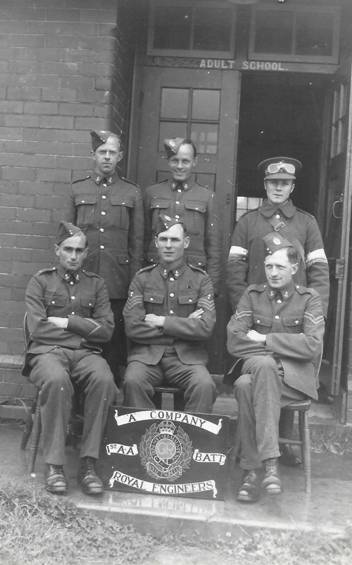
Figure
5. Corporal Jenkins (seated right)
with Men of “A” Company, 1st AA Battalion.
(Photograph Courtesy of Donald Jenkins)
Egypt
and Palestine (1936)
In
February of 1936 “A” Company of the 1st AA Battalion, R.E. along
with the remainder of the battalion deployed to Egypt aboard S.S.
Tuscania. By this time Jenkins
already was a Lance Corporal.[10]
The battalion disembarked at Alexandria on the 14th of February 1936.
On the 8th of March of 1936 he was appointed to the rank of
Temporary Corporal.
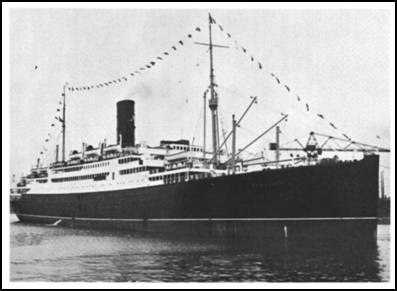
Figure
6. S.S.
Tuscania, circa 1936.
(Photograph courtesy of Wikipedia)
It was a short stay for him in Egypt, as his unit was ordered to Palestine on the 24th of July 1936. This move was necessitated by a countrywide revolt by Palestinians in April of 1936 against British rule in Mandatory Palestine and the official policy of support for Jewish immigration to the country. While interrupted by a cease-fire from October 1936 to September 1937, the rebellion reached its peak of intensity in 1938, before petering out in mid- to late 1939 with the approaching war in Europe. For long stretches of the rebellion the British lost control of Palestine, including many major towns and for about five days in October of 1938, they lost the Old City of Jerusalem. This was a substantial colonial revolt requiring a remarkably large force deployment by Britain; two full infantry divisions, or some 25,000 men, with supporting arms (including Jenkins’ 1st AA Battalion) by 1938. Most British infantry units served in Palestine at one time or another between 1936 and 1939.[11]
It is unlikely that Jenkins’ unit served in an anti-aircraft role during its time in Palestine. It is more likely that it was used in general support of ground operations during the revolt. Illumination in the streets of Jerusalem in search of insurgent forces probably was one of the main functions of Jenkins’ unit.
Corporal Jenkins received another Annual Report while serving in Palestine. His O.C. wrote:
“Employed as Chief Clerk. A very intelligent and capable man. Distinctly above average as regards clerical duties.”
From this report it is evident that Jenkins served a good deal of time with the company headquarters. He may have served with a searchlight section for part of his time in Palestine, but his records do not clearly indicate how he was utilized during his time there.
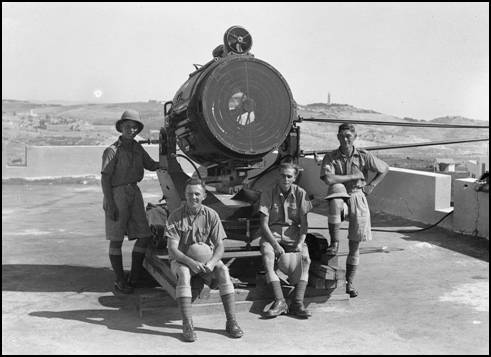
Figure
7. A Royal Engineers Search Light
Section in Jerusalem, c. 1936.
(Photograph courtesy
of Wikipedia)
Home Service (1936-1939)
The 1st AA Battalion, R.E. embarked at Haifa aboard S.S. California on the 21st of November 1936 and the unit disembarked at Southampton on the 30th of November. The unit was again assembled at Blackdown by the 1st of December and again took up its role as an anti-aircraft defense unit. Shortly after the battalion’s arrival in the U.K., Jenkins was promoted to the substantive rank of Corporal. His Annual Report, prepared on the 2nd of July 1937 indicated that he was:
“Thoroughly reliable. Outstanding personality with initiative.”
On the 28th of August 1937 he was posted to “M” Depot
Company at Chatham in preparation for a significant change in his military
career.
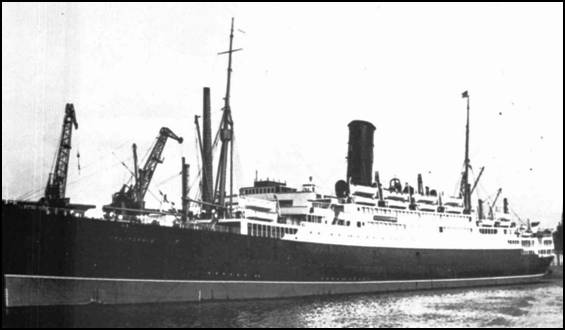
Figure 8. S.S. California, circa 1936.
(Photograph courtesy of Wikipedia)
Sometime during this period Jenkins was posted to the Establishment for Engineer Services (EES). This posting probably occurred in 1938, by which time Jenkins had passed trade courses with honors[12] for duties as a Clerk of Works and Military Foreman of Works (MFW Course No. 92), both duties employed by the EES. He already was a Lance Sergeant when he passed these courses. Why he was relieved of search light duties and posted to an entirely different line of work is unknown. It probably was the result of anti-aircraft searchlight duties being turned over to the Royal Artillery; hence the need for fewer men of the Royal Engineers to perform theses duties.
The EES dealt with the construction of fortifications, but by and large its greatest responsibility was in the area of the construction and maintenance of barracks. Other works undertaken by the Establishment included hospitals and Army Ordnance buildings. With regard to the latter, the work included not only the buildings themselves, but also the provision and maintenance of fixed machinery and the construction and maintenance of magazines and buildings for the storage of explosives, with special attention to precautions against fire and protection against lightning.
The EES also was involved with other buildings in support of the Army Service Corps, to include bakeries, stores, transport sheds and workshops. Special facilities such as refrigeration plants also were provided at Gibraltar and Malta and at other tropical locations. Many other buildings, such as churches, schools, offices, quarters for Commanding Officers and certain Staff Officers, also were provided by the EES. Other essential services of the Establishment included the charge of military cemeteries and burial grounds, the preparation of graves and the appointment and supervision of caretakers.
In connection with all of the above works, there was an organization within the EES responsible for the control of “Military Lands.” This term included the land on which the barracks and fortifications were constructed, along with roads, parades and recreation grounds. Closely allied to the control of “Military Lands” was the provision of rifle and artillery ranges.
One of the special branches within the EES included the Electrical Branch, which consisted of Defence Electric Lights, Telegraphs, Telephones, and Miscellaneous Electrical Services. The largest sub-element of the Electrical Branch was the Submarine Mining Service, which was responsible for the mine defences and also for the defence electric lights and electrical communications in the defended ports throughout the British Empire. Other miscellaneous electrical services included barracks lighting and protection of building against lightning. Some of the work of the Electrical Branch, especially that related to Defence Electric Lights, was closely related to the search light work that Jenkins was trained for and skills that he used in the AA battalion; hence, his experience in this line of work may explain his transfer to the EES.
A second special branch of the EES was the Mechanical Branch, with its responsibility for installation and maintenance of engines, boilers and machinery used with pumping and heating plant, and machinery used in Royal Engineers and Ordnance workshops. Other special branches of the Establishment were the Mechanical Transport Branch and the Railway Branch.
Lance Sergeant Jenkins was posted to the EES as a Military Foreman of Works on probation on the 1st of September 1938. On this date he also was appointed a Temporary Staff Sergeant and was posted for duty to the office of the Commander Royal Engineers (CRE) in the Home Counties Area (West). His Employment Report dated the 18th of October 1938 and written by the Deputy CRE stated that he was:
“Employed as Foreman of Works
since 1st Sept. Hardworking
and capable and should make a very good Foreman of Works.”
Service
on Malta (1939-1944)
Staff Sergeant Jenkins was posted to Malta as a Foreman of Works in the office of the CRE Malta on the 13th of April 1939, with his promotion to this substantive rank effective as of the 1st of September 1938. He traveled to Malta from Southampton aboard H.T. Dilwara and arrived on the island on the 21st of April for duty with the CRE (Works).
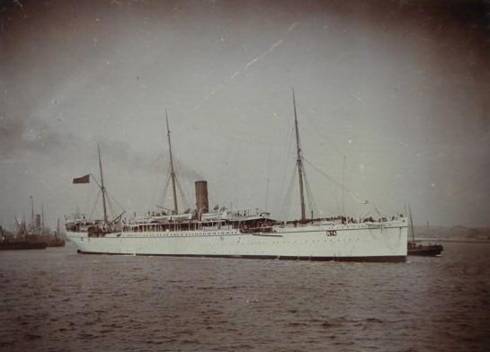
Figure
9. H.T.
Dilwara, circa 1938.
(Published by Unidentified Photographer, Aden)
Jenkins was on Malta during the German siege of the island when, from 1940 to 1942, the fight for the control of the strategically important island pitted the air forces and navies of Italy and Germany against the Royal Air Force (RAF) and the Royal Navy (RN).
The opening of a new front in North Africa in June 1940 increased Malta's already considerable value. British air and sea forces based on the island could attack Axis ships transporting vital supplies and reinforcements from Europe. Winston Churchill called the island an "unsinkable aircraft carrier." General Erwin Rommel, in de facto field command of Axis forces in North Africa, recognized its importance quickly. In May 1941, he warned that "Without Malta the Axis will end by losing control of North Africa"
The Axis resolved to bomb or starve Malta into submission, by attacking its ports, towns, cities, and Allied shipping supplying the island. Malta was one of the most intensively bombed areas during the war.
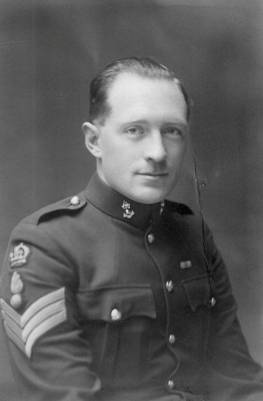
Figure 10.
Staff Sergeant Ernest Henry Jenkins, c. 1938.
(In this photograph he can be seen wearing the ribbon bar for the General
Service Medal 1918-1964 for his service in Palestine.)
(Photograph courtesy of Donald S. Jenkins)
The German Air Force and the Italian Royal Air Force flew a total of
3,000 bombing raids, dropping 6,700 tons of bombs on the Grand Harbour area
alone, over a period of two years in an effort to destroy RAF defences and the
ports. Success would have made possible a combined German–Italian amphibious
landing (Operation Herkules) supported by German airborne forces, but this did
not happen. Allied convoys were able to supply and reinforce Malta, while the
RAF defended its airspace, though at great cost in material and lives. In
November 1942 the Axis lost the Second Battle of El Alamein, and the Allies
landed forces in Vichy French Morocco and Algeria under Operation Torch. The
Axis diverted their forces to the Battle of Tunisia, and attacks on Malta were
rapidly reduced. The siege effectively ended in November 1942.[13]
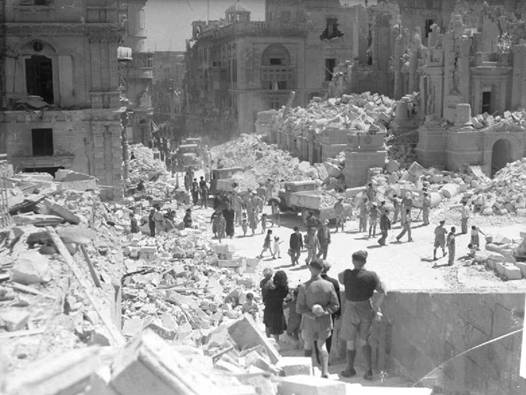
Figure
11. Bomb Debris on Malta.
(Photograph courtesy of Wikipedia)
Jenkins service on Malta qualified him for the award of the Africa Star. In addition to working on the construction and maintenance of fortifications on Malta, Jenkins would have been responsible for supervising the removal of large quantities of debris resulting from the almost constant bombing of the island and he most certainly would have been exposed to the dangers of the bombing as well. This work was accomplished using local labour and supervised by Jenkins and other officers and non-commissioned officers of the Royal Engineers.
On the 3rd of May 1940 Jenkins was awarded an increase in Service Pay at the rate of 8d. per diem. Service Pay, in addition to their regular pay, was granted to men in the Royal Engineers who demonstrated proficiency in their military duties.[14]
Jenkins received a medical examination on the 1st of June 1940
and was classified as being in Medical Category A1.
This category is the highest category of physical fitness that a British
soldier could obtain. It indicated
that he was “able to march, see to
shoot, hear well and stand active service conditions and that he was fit for dispatching overseas, as regards physical and
mental health, and training.” Despite
this categorization, Jenkins was admitted to hospital on the 9th of
July 1940, treated and released on the 27th of July 1940.
Unfortunately his service papers do not indicate the reason for his
hospitalization.
While
serving on Malta, Jenkins received a number of appointments and promotions
which, in typical fashion for the British army at the time make one’s head
spin. The following is a list of
these appointments and promotions:
· 26 August 1941: Appointed Unpaid Acting Quartermaster Sergeant.
· 14 September 1941: Appointed Paid Acting Quartermaster Sergeant.
· 18 September 1941: Promoted Quartermaster Sergeant Clerk of Works.
· 22 May 1942: Appointed War Service Warrant Officer Class II.
· 28 July 1943: Appointed Unpaid Acting Warrant Officer Class I (Clerk of Works).
· 1 September 1943: Appointed an Acting Warrant Officer Class I (Clerk of Works).
· 26 July 1944: Granted a War Substantive appointment to Warrant Officer Class I.
· 1 September 1944: Reverted to Warrant Officer Class II.
All of these appointments, many temporary in nature, undoubtedly were due to his excellent performance of duty and the need to grant him recognition for the outstanding work he was doing on Malta in positions of greater responsibility. Once the major cleanup work on Malta had been accomplished, Jenkins reverted to his former rank of Clerk of Works Quartermaster Sergeant (Warrant Officer Class II) on the 1st of September 1944.
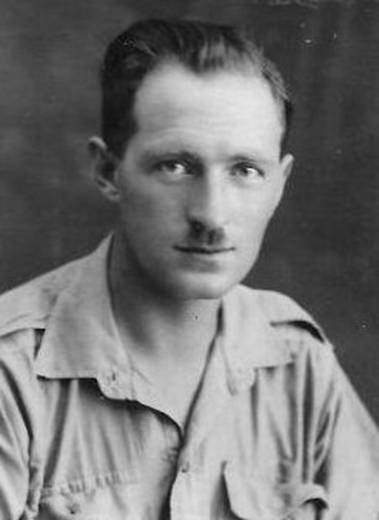
Figure 12. Warrant Officer
Class II Jenkins on Malta, circa 1944.
(From his military driver’s license, courtesy of Donald Jenkins)
During his period of service on Malta, Jenkins was granted two periods of five days leave from the 26th of October to the 30th of October 1942 and from the 8th of March to the 12th of March 1943. The photograph above was taken from his military driver’s license issued to him on the 1st of January 1944. It shows a rather thin Ernest Henry Jenkins in an ill-fitting tropical uniform as he appeared while serving on the staff of the CRE (West) on Malta. It is curious to note that his license was valid only to drive on Wednesdays! One wonders how he got around the rest of the week!
His service papers show that on the 3rd of January 1944 he assumed the duties of Clerk of Works-In-Charge, Engineer Division, Malta. In this capacity he was assigned to the R.E. Works Service Malta and was granted additional Service Pay. He received his Africa Star for service on Malta on the 31st of January 1944.
According to his son Donald, Jenkins had some trying experiences while he was on Malta. Donald told the author that his father did not talk much about his duties on Malta but it appeared that his time was spent building air-raid shelters, demolishing unsafe buildings and building and setting up defences against invasion in addition to being responsible for the maintenance of a major military hospital. One of his stories was that while sitting on a veranda outside his office he watched a German aircraft on a dive bombing run towards him, drop a stick of bombs which exploded in succession while getting closer to him. As he counted the explosions he could not remember how many bombs were in the stick but realised that the next one would land on him. Fortunately for him there was not a next one! He was frozen to his seat as he had ‘tons’ of high explosives in his office available to demolish unsafe buildings. Another story was of one of the shelters he built which took a direct hit. There was only one person in the shelter who, when rescued, is alleged to have said “Bugger off, I’m on my way to heaven” – his last memory before blacking out from the blast was an almighty ‘zing’ noise when the top of the ventilation shaft was sheared off. He thought this was the noise of angels carrying him off to heaven!
On the 15th of March 1944 Jenkins re-engaged to complete 21 years of service with the Colours and on the 1st of July of that year he married Hilda Grace at Sliema[15] on the northeast coast of Malta (see Section 9 for family details). The wonderful photograph of the couple shown in Figure 12A below shows Hilda in her WRNS uniform and Ernest in his tropical service dress uniform. He is wearing the ribbon bars of his General Service Medal and his Africa Star Medal.
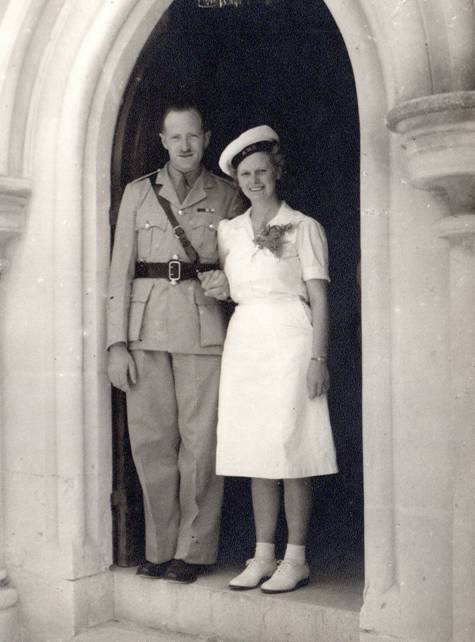
Figure
12A. The Wedding of Ernest and Hilda
Jenkins in Malta.
(Photograph courtesy of Donald Jenkins)
Home Service (1944-1950)
Clerk of Works Quartermaster Sergeant Jenkins returned home on the 4th of December 1944 and was employed at the office of the Chief Engineer, Western Command with a further posting to the office of the Chief Engineer, North West District. In the North West District he was assigned to the CRE Lancashire for duty under the Deputy CRE Preston. These posting took place between his arrival back in the UK and the 23rd of January 1945.
During the period from the 13th to the 27th of February 1945 Jenkins attended the Military Foreman of Works (Refresher) Course at the School of Military Engineering at Ripon in North Yorkshire.[16] He was granted 10 days leave from the 2nd of March to the 11th of March 1945 and upon his return to duty on the 12th of March he was posted to “J” Company of the School of Military Engineering at Ripon, presumably as an instructor in one of the training battalions. On the 2nd of May he was granted Good Conduct Pay at the rate of 3d. per day. His service papers show that on the 20th of September 1945 he was on the strength of the 10th Depot Battalion, R.E. at Ripon and that he remained with that unit until he was granted a commission. While serving at Ripon he was presented with his Defence Medal on the 21st of February 1946 and with the War Medal on the following day (see Section 8). He was granted special “End of War” leave on the 29th of June1946 and returned to duty on the 17th of July. On the 4th of August 1946 he re-engaged to complete 22 years of service. Jenkins took advantage of a regulation that permitted Warrant Officers and Non-commissioned Officers to continue in the service after 21 years and thus earn a higher pension. Leave for such a continuance of service had to be obtained from higher authorities and men on such prolonged service could claim their discharge at any time upon three months’ notice. In Jenkins’ case it was obvious that he had something more than a higher pension in mind; that is, a commission.[17] In June of 1946 the Commander-in-Chief of the Eastern Division awarded Jenkins a Certificate of Achievement for his service in that command. Although the certificate is dated June 1946 Jenkins’ service papers indicate that he actually was not presented with the certificate until the 9th of August 1946. No explanation is given in service papers to account for the delay in making the presentation. A copy of the certificate is presented below showing Jenkins’ rank as a Warrant Officer Class I (Clerk of Works).
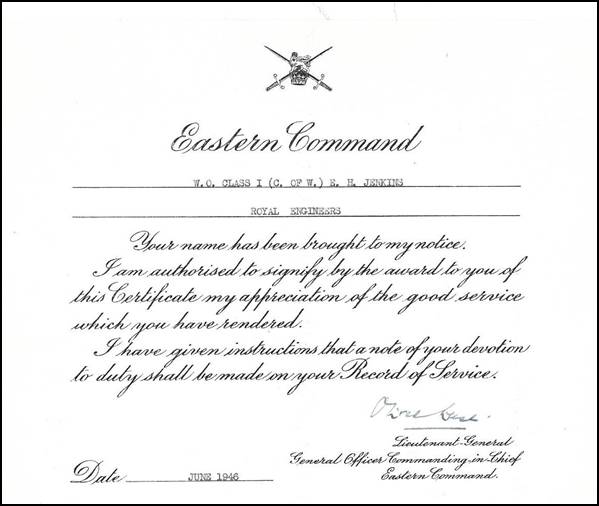
Figure 13. Eastern Command
Certificate of Appreciation.
(Image courtesy of Donald Jenkins)
On the 3rd of October 1946 Warrant Officer Class I Ernest Henry Jenkins was discharged from the ranks for the purpose of being appointed to a commission in the Royal Engineers.[18] At the time he was serving in the 10th Depot Battalion, R.E. and his total service in the ranks was reckoned at 14 years 153 days. A Testimonial in his service papers upon his discharge reads as follows:
“A
competent and efficient Warrant Officer who has given many years good and loyal
service. Since 1938 has been
employed with the Engineer Services as a Clerk of Works, in which appointment he
has given every satisfaction. He is
keen and industrious and possesses initiative and tact above average and has
gained the confidence and respect of both his superiors and subordinates.
He is honest, sober and trustworthy and strongly recommended for any
position of trust. He is discharged
in consequence of heaving been appointed to a commission.”
On the 4th of October 1946 Clerk of Works Quartermaster Sergeant Jenkins was commissioned as a 2nd Lieutenant in the Royal Engineers and was posted to the 3rd Training Regiment, R.E. The Supplement to the London Gazette dated 22 November 1946 (page 3718) indicates that he was granted an “Immediate Emerg. Commis. from the ranks in the rank of 2nd Lt.” His new Army Number as an officer is shown as 371300. On the 1st of June 1947 he was promoted to the rank of Lieutenant (Quartermaster) with seniority dating from the 4th of October 1946.[19]
On the 15th of February 1947 Lieutenant Jenkins was posted to the Royal Engineers Depot and attached to the Chatham Wing of the School of Military Engineering for consideration as an Instructor.
Lieutenant Jenkins was posted to the Ripon Wing of the School of Military Engineering on the 1st of January 1949. He was appointed the Publications Officer with the rank of Temporary Major. During this period he was involved with producing reference works for the Army, the subjects of these works included “Building Site Practice” and “Sanitary Engineering.”[20] In March of 1949 he was transferred to the Construction School of the SME as an Instructor and on the 1st of May 1949 he reverted to the rank of Captain.
Jenkins was again appointed a Temporary Major on the 20th of January 1950,[21] and on the 3rd of May 1950 he was awarded the Army Long Service and Good Conduct Medal (GVIR) after completing 18 years of service.
Service
in India (1951-1955)
Temporary Major Ernest Henry Jenkins sailed from the Port of London for Bombay, India, via Port Said, aboard the Scindia Steam Navigation Company ship Jalazad on the 20th of January 1951.[22] The ship’s passenger lists shows him as having Contract Ticket Number 3678, age 40 years. It also shows his address in the U.K. as 539 Maidstone Road, Wigmore, Gillingham and lists his Profession as “Officer.”
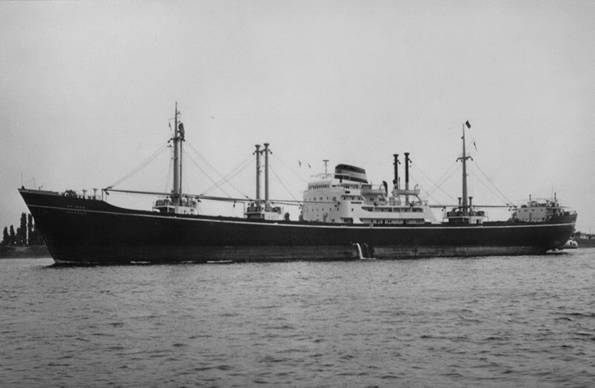
Figure 14. S.S. Jalazad, circa
1951.
(Photograph courtesy of Wikipedia)
Major Jenkins was accompanied to India by his family. Amidst the chaos of the Bombay railway station they boarded a train for Poona. During the voyage to India the children had measles and had been quarantined in the Captain’s suite just behind the bridge and young Donald spent half the journey on the bridge.
Upon his arrival in India on the 10th of February 1951, Jenkins was seconded to the Indian Army College of Military Engineering at Kirkee, near Poona where he was appointed an Instructor, Class “C” and shortly thereafter an Instructor, Class “B.”
While serving at Kirkee he was under the command of Brigadier Reginald (Rex) Edmund Holloway. Holloway and Jenkins apparently were friends in addition to being commander/subordinate. In his diary dated the 10th of July 1952 Holloway wrote:
“To a good flick ‘Seven Days to Noon’ and then back to dine with Jenkins.”
Mrs. Jenkins also was probably at this dinner.[23]
On the 14th of December 1951 Jenkins was promoted to the substantive rank of Captain (Quartermaster),[24] but he continued to serve at the College as a Temporary Major.[25] He remained in this assignment until the 25th of March 1955 when he was struck off the strength of the SME Kirkee and relinquished his appointment as an Instructor, Class “B.” On the 13th of April of 1955 his secondment to the Indian Army ended.
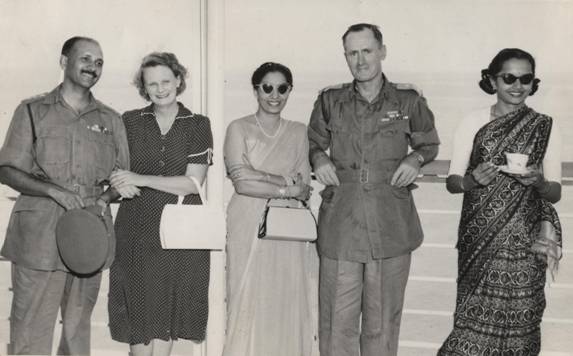
Figure
15. Mrs. Jenkins (2nd
from left) and Brigadier Holloway (2nd from right).
(Photograph courtesy of Donald Jenkins)
Home
Service (1955-1960)
Jenkins was posted home and arrived in Liverpool from Bombay aboard RMS Circassia on the 13th of April 1955. He was posted to the Royal Engineers Depot initially and then reported to his new assignment at the Office of the Chief Engineer, Western Command at Chester on the 20th of June 1955. On the 4th of July 1955 he was assigned as a Staff Officer, Royal Engineers, Class III (Works).
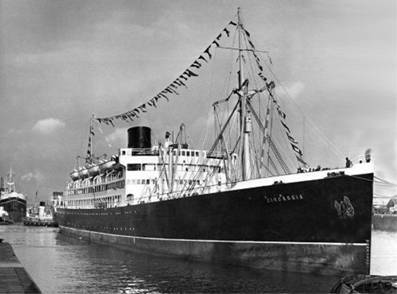
Figure 16.
RMS Circassia.
(Photograph courtesy of Anchor Line)
The 1956 Annual Army List shows Jenkins serving in the Western Command as a Captain (Quartermaster) and as an attached staff officer to the command headquarters as indicated above.
Jenkins was promoted to the rank of Major on the 14th of December 1957[26] and on the 19th of September 1958 he was posted to the Office of the CRE East and West Riding in Strensall, North Yorkshire where he remained until the 20th of March 1960 when he was attached to the Army Apprentice School, Carlisle, as the officer in charge of administration and discipline. Apparently this was assignment to Carlisle was only a temporary one.[27]
Service
in the Cameroons (1960-1961)
On the 1st of August 1960 Major Jenkins was posted to the Southern British Cameroons as the Officer Commanding, 160 Works Section, R.E. While commanding 160 Works Section he assisted in the supervision of the building of three camps for British troops alongside 59 Field Squadron, a unit commanded by Major Hugh Patrick Cunningham.[28] 160 Works Section was a strange organization, as it only consisted of six non-commissioned officers (Clerks of Works) and Major Jenkins. It appears to have been an ad hoc unit created to supervise work, perhaps the work of indigenous personnel. 59 Field Squadron arrived in the Cameroons a couple of weeks after Jenkins arrival and took over most of the construction operations.
The work undertaken by the engineers included improving roads and camps
for a battalion of the Kings Own Royal Border Regiment, which arrived there in
September of 1960. These camps were
located at Bamenda in the north, at Buea in the south and at
Kumba in the center of the region.[29] The
battalion was to provide a military presence in the region until a plebiscite in
February of 1961 when the Southern British Cameroons decided to join with the newly
independent French Cameroons. Jenkins
kept a diary of his time in the Cameroons that noted primarily where he went and
described the incompetence of the civil service (presumably British) and the
awful weather. The following is a
short excerpt from that diary as it relates to his work there:
“1.7.60 Formed Section at Chatham – met all men less Green. Gave brief. Obtained extension of luggage weight to 88lbs self & 77 for chaps. Depot staff gave every assistance. Met OC 59 Field Squadron RE – Maj H. P. Cunningham who asked for D.O. report of conditions, shortages etc & if I would look after his pre-advance party, Lt Jarman & 2 NCO’s who are to arrive BC approx. 21/7”.
Home
Service (1961-1963)
Major Jenkins deplaned from Africa on the 19th of November 1960 after
completing his work in the Cameroons. On
the 19th of March 1961 he was attached to the Camp Commandant at Headquarters
Northern Command for duty with the Chief Works Officer in that command.
On the 9th of April 1961 he was assigned the duties of Garrison Works
Officer with the Northern Command[30] and he received his promotion to Regular Army Major
(Quartermaster) on the 1st of August 1961.
Major Jenkins retired from the Army on the 9th of December 1963 and was
placed on the rolls of the Reserve of Officers.
He was released from the Reserve of Officers on the 9th of November 1965
having attained the age limit to liability for recall to the Colours.
The following sections are presented in tabular form to summarize
Jenkins’ promotions, appointments, military training and qualifications and
the medals that he was awarded during his time in the Army.
They are provided to give the reader easy access to these aspects of
his military career. The tables
are followed by sections dealing with his marriage, personal information and
post-service life.
6.
PROMOTIONS AND APPOINTMENTS
Ernest Henry Jenkins received the following promotions during his time in service:
Date of Promotion or Appointment |
Rank
or Position |
|
4 May 1932 |
Sapper upon enlistment in the Corps of Royal Engineers. |
|
5 Apr 1934 |
Appointed Acting Lance Corporal. |
|
1 Jan 1935 |
Promoted Lance Corporal. |
|
8 Mar 1936 |
Appointed Temporary Corporal. |
|
10 Dec 1936 |
Promoted Corporal. |
|
2 Sep 1937 |
Promoted Lance Sergeant. |
|
1 Sep 1938 |
Promoted Staff Sergeant (Foreman of Works) |
18
Sep 1941
|
Promoted Quartermaster Sergeant (Clerk of Works) |
|
1 Sep 1943 |
Appointed Warrant Officer Class I (Clerk of Works) |
|
26 Jul 1944 |
Appointed War Substantive Warrant Officer Class I (Clerk of Works). |
|
1 Sep 1944 |
Promoted Warrant Officer Class II (Clerk of Works QMS). |
|
4 Oct 1946 |
Commissioned 2nd Lieutenant, Royal Engineers. |
|
1 Jun 1947 |
Promoted Lieutenant. |
|
20 Jan 1950 |
Appointed Temporary Major. |
|
14 Dec 1951 |
Promoted Captain (Temporary Major). |
|
13 Apr 1955 |
Relinquished appointment as Temporary Major. |
|
14 Dec 1957 |
Promoted Major. |
7.
MILITARY TRAINING AND QUALIFICATIONS
Military Training: Jenkins received the following military training during his time in service:
Dates |
Course
of Training |
|
4 May 1932 |
Completed Trade Course: Carpenter and Joiner Class BII. |
|
3 Sep 1932 |
Awarded a 2nd Class Certificate of Education. |
|
22 Mar 1933 |
Awarded a 1st Class Certificate of Education (Distinguished in Mathematics and Map Reading). |
|
30 Jan 1934 |
Completed Search Light Operator Course, Class DII. |
|
25 Jul 1937 |
Completed Clerk of Works Course, Class CII. |
|
1 Sep1938 |
Completed Military Foreman of Works Course. Awarded the Fowke Medal and Stokes Roberts Prize for best student in the Royal Engineers School of Construction.[31] |
Date |
Qualification |
|
4 May 1932 |
Carpenter and Joiner. |
|
30 Jan 1934 |
Searchlight Operator. |
|
1 Sep 1938 |
Foreman of Works (Establishment for Engineer Services). |
|
18 Sep 1941 |
Clerk of Works (Establishment for Engineer Services). |
|
20 Jan 1950 |
Instructor, Indian School of Military Engineering. |
|
4 Jul 1955 |
Engineer Staff Officer (Quartermaster). |
|
14 Dec 1957 |
Garrison Engineer. |
Major Jenkins received the following medals, awards and decorations during his time in service:
|
Medal
or Award |
|
General Service Medal 1918-1964 with clasp [PALESTINE] |
|
1939 – 45 Star Medal |
|
Africa Star Medal |
|
Defence Medal |
|
War Medal |
|
Long Service and Good Conduct Medal (GVIR) |
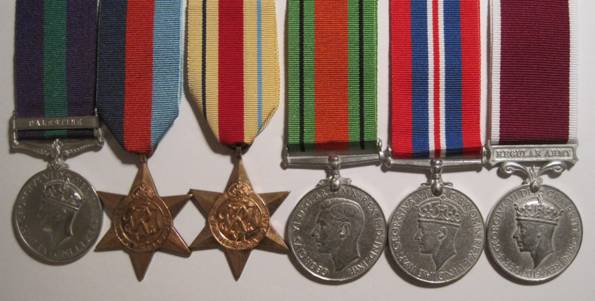
Figure 17. Representative
Group of the Medals of Major Ernest Henry Jenkins, R.E.
(From the author’s collection)
9.
MEDICAL INFORMATION
In addition to the medical information contained in his Attestation
documents and the fact that he spent some time in hospital while serving on
Malta, his Medical Profile also is provided in his service papers based on
examinations and evaluations of him between June of 1947 and January of 1960.
The following
are the results of these evaluations in the British Army’s PULHHEEMS System:[32]
|
P. |
U. |
L. |
H. |
E. |
E. |
M. |
S. |
P.E.S. |
Date |
|
2 |
2 |
2 |
2 |
2/1 |
1/1 |
2 |
2 |
FE |
6/6/47 |
|
2 |
2 |
2 |
1 |
2/1 |
1/1 |
2 |
2 |
FE |
23/3/49 |
|
2 |
2 |
2 |
1 |
2/ |
1/ |
2 |
2 |
FE |
19/7/55 |
|
2 |
2 |
2 |
1 |
2/1 |
1/1 |
2 |
2 |
FE |
23/7/56 |
|
2 |
2 |
2 |
1 |
2/1 |
1/1 |
2 |
2 |
FE |
1/8/57 |
|
2 |
2 |
2 |
1 |
2/1 |
1/1 |
2 |
2 |
FE |
12/1/59 |
|
2 |
2 |
2 |
1 |
2/1 |
1/1 |
2 |
2 |
FE |
12/1/60 |
NOTES:
In all areas Jenkins was found to be fully fit for military duties during
each of his medical examinations by not having a designation in any area lower
than 2. According to profile his
hearing actually improved with time – unless the evaluation made in June of
1947 was faulty. His eyesight in his
right eye was somewhat better than in his left, but still satisfactory for
military service.
10. MARRIAGE, FAMILY AND
PERSONAL INFORMATION
While serving on Malta, Jenkins met and married his wife, Hilda Grace, who was a Leading WREN in the first contingent of 40 WRNS[33] ratings and one officer that arrived on the island in January of 1943. That Jenkins was well respected by the men who worked for him on Malta is evident from the arrangements made by them for Ernest’s and Grace’s wedding. A boat was arranged, bedecked with flowers, to row them from the north of the island to Gozo[34] for their honeymoon.[35]
The Jenkins Family Tree indicates that Ernest and Hilda had the following children:[36]
· Daughter: Pauline F. Jenkins, born in Manchester on the 25th of May 1945.
· Son: Donald S. Jenkins, born in Chatham, Kent on the 22nd of November 1946.
· Daughter: Margaret K. Jenkins, born in Chatham on the 26th of December 1948.
At the time of Pauline’s birth the Jenkins were residing at 55 Palatine Road, Withington, Lancaster, Lancashire.
AUTHOR’S NOTE: The information above was taken from the Jenkins Family Tree cited in the REFERENCE section, but it is questioned by Donald Jenkins. Donald does not recognize the Palatine Road address nor does he believe that the information concerning his sister’s birth is accurate. He is certain that his sister was born at 10 Turner Street, Gorton, Manchester as, on returning from Malta and being discharged from the WRNS his mother stayed with her mother until after the birth. She then had a stay with her husband’s parents before she and Ernest found accommodation in Kent.[37] Apparently there were no married quarters available in Chatham so Jenkins was left to find accommodation in the private sector – difficult because of bomb damage and people relocated from London during the war. Since the validity of the information taken from the cited family tree is questionable, the author believes that Donald Jenkins’ personal remembrances should be considered to be the most accurate description of the events presented.
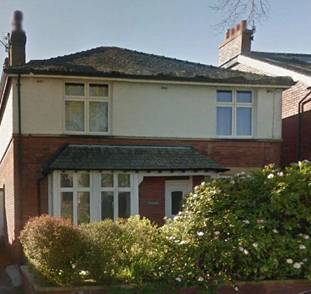
Figure 18. The Jenkins’s
Residence at 55 Palatine Road, Lancaster, circa 1945.
(Photograph courtesy of Google Earth)
The Jenkins were residing at 539 Maidstone Road, Wigmore, Gillingham about the time of Margaret’s birth. Google Earth shows this address to be a very handsome wooded lot with a fine brick wall in front and a structure that perhaps is a little too modern to have been the Jenkins residence in 1948.
AUTHOR’S NOTE: Based on the previous author’s note regarding the birthplace of Margaret Jenkins, the information contained in the paragraph above is dubious. Furthermore, the house depicted in Figure 18 above appears not to have been a residence of the Jenkins family. Nowhere on Hilda Jenkins’ National Registration Identity Card does this address appear (see Addendum No. 1).
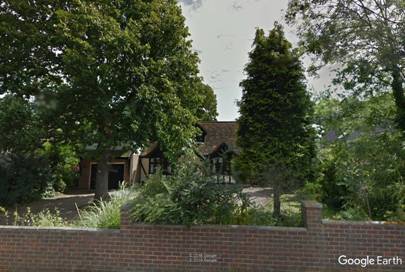
Figure 19. The Residence at
539 Maidstone Road, Gillingham, Kent, c. 2019.
(Photograph courtesy of Google Earth)
Jenkins’ mother had two cousins, William Thomas Robb Birrell, MC and Thomas John Robb Birrell, MBE who were Non-Commissioned Officers in the East Kent Regiment (The Buffs) prior to and during the Great War of 1914-1918.[38] The Medal Index Card (MIC) for William is shown below. The card shows his name as William Robb Birrell, leaving out the name Thomas as indicated by Donald Jenkins. Two middle names probably was too much for the Medal Office to handle, but there is no doubt that this man was Maud Birrell’s cousin.
The card clearly shows the William was a Warrant Officer Class I in the East Kent Regiment prior to the war and that he started the war as a 2nd Lieutenant in the regiment. By the end of the war he had risen to the rank of Captain. He went to France in January of 1915 and apparently served there for the duration of the war. The reverse side of the MIC (the lower image) shows that in 1920 he had two addresses: The Military Police Record Office in Aldershot, Hampshire, which apparently was his then military postal address and 194 Balmoral Road, Gillingham, Kent, his permanent address.
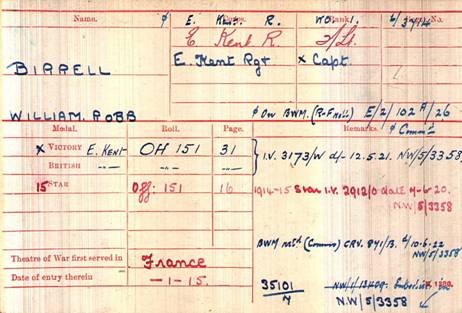
Figure 20A.
The Great War Medal Index Card of Captain W.T.R. Birrell (front).
(Image courtesy of Ancestry.com)
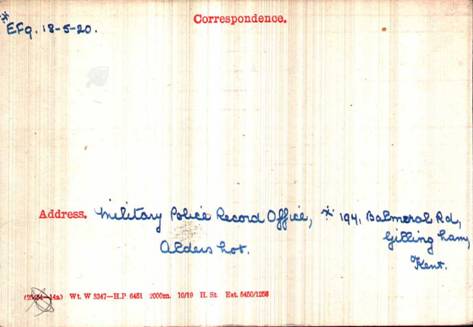
Figure
20B. The Great War Medal Index Card
of Captain W.T.R. Birrell (back).
(Image courtesy of Ancestry.com)
The Great War was not W.T.R. Birrell’s first war. A description accompanying the auction of his medals by Dix Noonan Web (DNW) in 1999 reads as follows:
“A Great War M.C. group of eight awarded to Major W.R. Birrell, East Kent Regiment: Military Cross, GVR, the reverse inscribed ‘Capt, 1st Bn. The Buffs 1917: Queen’s South Africa 1899-1902. 2 clasps, Relief of Kimberley, Orange Free State (3714 C. Sgt.[39] East Kent Regt.): 1914-15 Star (2nd Lieut. E. Kent R.): British War Medal and Victory Medals, with M.I.D[40]. oak leaf (Capt.): War Medal:[41] Coronation 1937: Army L.S.& G.C. EVIIR (3714 C. Sgt. E. Kent Regt.). M.C. London Gazette 1 January 1917.”
The DNW description adds the following details regarding his life:[42]
“William Robb Birrell was born on 22 January 1874,[43] and entered the Buffs in 1892. He served with the 2nd Battalion Mounted Infantry in South Africa during the Boer War and was wounded in the head at Klip Kraal on 16 February 1900, being invalided home on 16 July. He was commissioned in The Buffs on 9 January 1915, becoming Adjutant of the 1st Battalion at the end of the year, and Lieutenant (Temp/Captain) on 18 January 1916, and promoted to Captain on 30 November 1916. He went to France in January 1915 and was present with the 1st Battalion at the action at Hooge, 9-12 August 1915. During the Second World War he was Adjutant of No. 3 A.M.P.C.[44] Centre at Richborough and was later in charge of a centre dealing entirely with German, Austrian and Polish refugees from Nazi oppression, which earned for him the appreciation of the Commanding Officer of the Centre, the Marquis of Reading. When the Centre was disbanded in 1942 Major Bill Birrell returned to his British Legion post in London.”


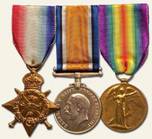



Figure 21.
Images of the Medals Awarded to Major Birrell.
NOTE:
These are not his actual medals, but simply representative images as described
in the DNR auction catalogue.
Birrell’s family tree cited in the REFERENCE section of this narrative indicates that in 1881 he was living in St. George Bloomsbury, London and by 1891 he was in Gillingham, Kent. He married Elizabeth Costelloe (1876-1961) at Holy Trinity Church in Old Brompton, Gillingham on the 11th of September 1899. In addition to the military information provided in the DNW auction catalog above, the family tree shows that he served as Sergeant Major of the 2nd Battalion of The Buffs in the Singapore Straits in 1911. In 1939 he was the Organizing Secretary for Retired Officers of the Royal British Legion in Kent. He died on the 1st of March 1954 at Farnborough Hospital in Bromley.
The Medal Index Card for Thomas John Robb Birrell, MBE is shown below. The card shows that Thomas entered the war as a Sergeant (Regimental Number L/8789) in the East Kent Regiment and was a Colour Sergeant when the war ended. Like his brother William’s MIC, Thomas’s card omits the middle name Robb.[45] The Birrell Family Tree shows that the name Robb was passed down from the grandmother of both men. Thomas went to France on the 7th of September 1914 and was therefore eligible to receive the 1914 Star with clasp as shown below. His other medals would have been the British War Medal and Victory Medal, the same as those earned by his brother William.
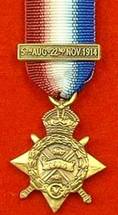
Figure 23. The 1914 Star and Bar.
(Image courtesy of Wikipedia.com)
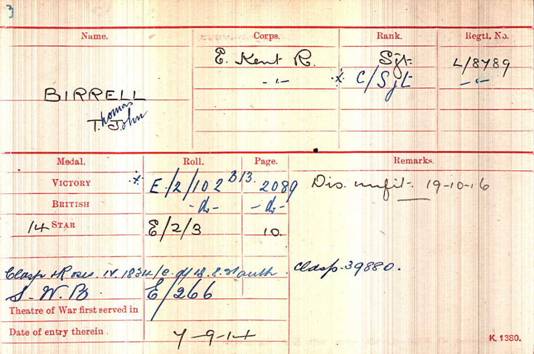
Figure
22. The Great War Medal Index Card
of Colour Sergeant T.J.R. Birrell.
(Image courtesy of
Ancestry.com)
Colour Sergeant Birrell was wounded in action and was awarded the Silver War Badge as shown on the roll below. He was discharged as unfit for further service on the 19th of October 1916. It appears that Thomas lost a leg. The Birrell brothers were very tall – William rumoured to be 6’ 7” and Thomas a bit shorter and more likely to lose his head than his leg![46]
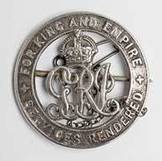
Figure
24. The Silver War Badge.
(Image courtesy of Wikipedia.com)
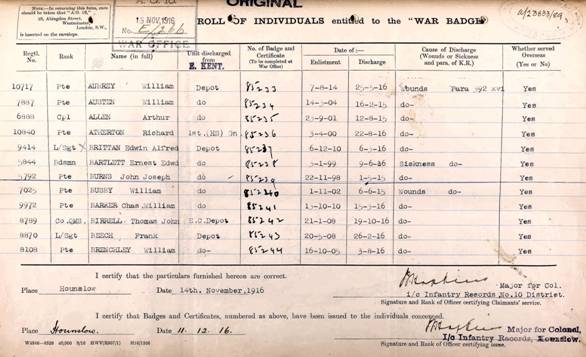
Figure 25.
The Silver War Badge Roll Page Naming T.J.R. Birrell.
(Image courtesy of Ancestry.com)
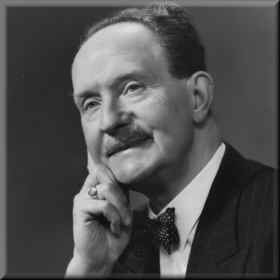
Figure 26.
Thomas John Robb Birrell, M.B.E.
(Photograph courtesy of the Birrell Family Tree – JOHNCAMPBELL433)
Thomas John Robb Birrell was born on the 29th of June 1892 in Gillingham, Kent. His family’s residence at the time was Stanley House, Old Brompton, Gillingham. He married Kate Day (1889-1964) in 1913 at Medway, Kent. He and Kate had a daughter, Eunice Evelyn Birrell (1917-1935) and a son, Maurice Thomas Robb Birrell (1928-1974). In 1939 the Birrell’s were living at 43 Pagoda Avenue in Richmond, Surrey where Thomas was the Secretary of the British Legion and United Services Fund. In 1950 he was the Secretary of the Benevolent Department of the Royal British Legion Headquarters in London and in 1952 he was awarded the M.B.E. for his service. By 1958 the Birrells were residing at 9 Bournville Avenue in Chatham. Thomas died at Oakwood Hospital in Maidstone, Kent on the 9th of June 1958. More details of his life are available at on his family tree, the Internet address of which may be found in the REFERENCE section at the end of this narrative.
Donald Jenkins believes that it was the service of these two men that inspired his father to enlist in the Army.
Jenkins’ mother, Maud, age 71, died in Sheffield, West Riding of Yorkshire, on the 1st of October 1950. His father, Stuart, age 79, passed away on the 25th of January 1963, also in Sheffield and he lost his brother Stuart David, age 62, who was residing in St. Albans, Hertfordshire, in September of 1969.
11. RELEASE FROM SERVICE
Major Jenkins was released from service on the 9th of December 1963. He served in the Reserve of Officers until the 9th of December 1965. His total service was reckoned as shown in the tables below:
Location |
Period
of Service |
|
Home |
4 May 1932 to 4 February 1936 |
|
Egypt |
5 February 1936 to 23 July 1936 |
|
Palestine |
24 July 1936 to 30 November 1936 |
|
Home |
1 December 1936 to 12 April 1939 |
|
Malta |
13 April 1939 to 3 December 1944 |
|
Home |
4 December 1944 to 20 January 1951 |
|
India |
21 January 1951 to 25 March 1955 |
|
Home |
26 March 1955 to 31 July 1960 |
|
Southern Cameroons |
1 August 1960 to April 1961 |
|
Home |
April 1961 to 9 December 1963 |
Location |
Period
of Service |
|
Home
Service |
21
years and 76 days |
|
Service
Abroad |
10
years and 150 days |
Total Service |
31
years and 226 days |
NOTE: Where only months
and years are given in the tables above the periods of service are only
approximate, using the middle of the month for the approximation.
12. POST SERVICE LIFE
After his retirement from the Army Ernest Henry Jenkins worked as a
contracts planner for a construction company.
He also subsequently worked as the company’s Health and Safety Officer.
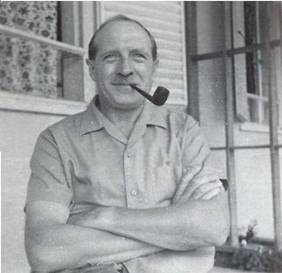
Figure 27. Ernest Henry
Jenkins, c. 1960.
(Photograph courtesy of Donald Jenkins)
Jenkins died of cancer in Harrogate, North Yorkshire on the 22nd of June 1975, age 64. His address at the time of his death was 22 Woodlands Drive, Harrogate. His will was probated in Leeds. Effects: £3,577 (about $40,300 US in 2019 currency).
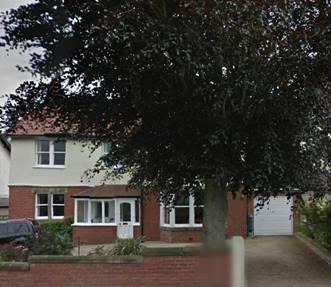
Figure 28. Ernest Henry
Jenkins’ Home at 22 Woodlands Drive, Harrogate.
(Photograph courtesy of Google Earth)
Locations Where
the Jenkins Resided from 1945 to 1948.
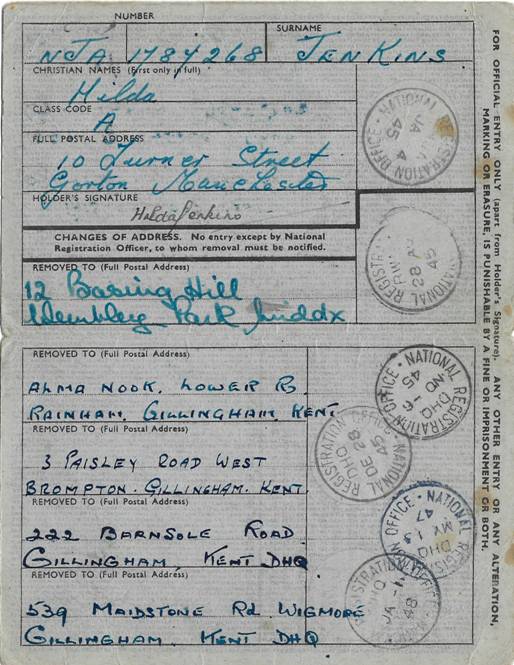
A check of the addresses listed in the ID Card on Google Earth indicates
the following:
10 Turner Street, Gorton, Manchester.
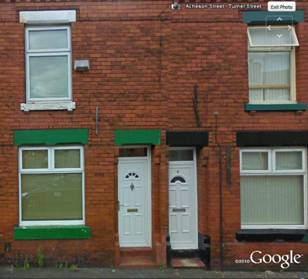
Figure 30. The Jenkins
Residence at 10 Turner Street, Gorton, Manchester.
(Photograph courtesy of Google Earth)
12 Basing Hill, Wembley Park, Middlesex
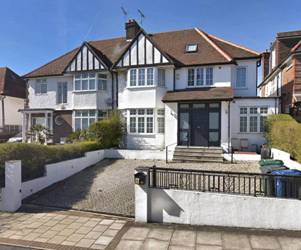
(Photograph courtesy of Google Earth)
·
The address at Alma Nook, Lower Road, Rainham, Gillingham, Kent
could not be found on Google Earth.
·
The address at 3 Paisley Road West, Brompton, Gillingham, Kent
could not be found on Google Earth.
·
222 Barnsole Road, Gillingham, Kent is still a residential
address.
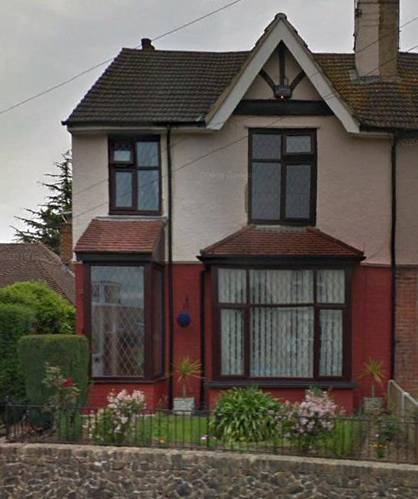
Figure
32. The Jenkins Residence at 222
Barnsole Road, Gillingham, Kent.
(Photograph courtesy of Google Earth)
·
The address at 539 Maidstone Road, Wigmore, Gillingham, Kent is
shown in Figure 19 of the narrative.
ADDENDUM NO. 2
The confusion regarding the 55 Palantine Road address discussed in Section 10 was clarified by Donald Jenkins in an email to the author dated 12 September 2019. After further research by Don it was determined that there is a 55 Palantine Road in Withington, Manchester, which in 1945 was a nursing home and was where his sister was born. The Place of Birth noted on his sister’s birth certificate is 55 Palantine Road. His father registered her birth and his residence at the time was 10 Turner Street.
Army Lists
Books
4.
SKELLEY, A.R.
The Victorian Army At Home: The Recruitment and Terms and Conditions of
the British Regular, 1859-1899. Mc
Gill-Queen’s University Press, Montreal, 1977, p. 94, 95, and 311.
Census Data
1911 Census of England and Wales.
Documents
1.
1.
Diary
of Brigadier Reginald (Rex) Edmund Holloway in the author’s possession.
2.
2.
Diary
of Major Ernest Henry Jenkins, 4 to 6 August 1960.
3.
3.
Hilda
Jenkins’ National Registration Identity Card.
Family
Trees
https://www.ancestry.com/family-tree/person/tree/12405894/person/280511807/facts
Internet
Web Sites
London
Gazette
Medal
Rolls
Official Registers
Passenger Lists
Periodicals
4.
The Sapper,
September 1934, p. 378.
Personal Communication
Personal Communication with his
son, Donald Jenkins with information from the officer’s service papers.
Royal Engineers Lists
Service Papers
[1] These reproduction medals were obtained from Poppy Medal Framing, a firm that makes excellent reproductions of British military medals from all periods. Poppy Medal Framing may be contacted at www.poppymedalframing.co.uk.
[2]In
1861 a new inducement towards learning was the army certificate of
education. On the recommendation
of the Council of Military Education three levels or standards were set out
and were linked with promotion in the ranks.
The third-class certificate specified the standard for promotion to
the rank of corporal: the candidate was to read aloud and to write from
dictation passages from an easy narrative, and to work examples in the four
compound rules of arithmetic and the reduction of money.
A second-class certificate, necessary for promotion to sergeant,
entailed writing and dictation from a more difficult work, familiarity with
all forms of regimental accounting, and facility with proportions and
interest, fractions and averages. First-class
certificates were a great deal more difficult and were required for
commissions from the ranks. Successful
candidates had to read and take dictation from any standard author; make a
fair copy of a manuscript; demonstrate their familiarity with more
complicated mathematics, except cube and square root and stocks and
discount; and as well prepare for examination in at least one of a number of
additional subjects. After 1887
candidates were examined in British history and geography in place of a
special subject. First-class
certificates were awarded on the results of periodic examinations held by
the Council (later Director-General) of Military Education.
Second and third-class certificates were presented on the
recommendations of the Army schoolmaster.”
“The third-class certificate of education was considered to be too
high given the level of literacy of many army recruits, and the Commission+
urged the introduction of a fourth (minimum) standard. (Ref: Skelley.)
[3] This experience probably was gained while working for his father’s building firm.
[4] Military uses have included locating submarines and aircraft. The first use of this type of equipment was claimed by Commander Alfred Rawlinson of the Royal Naval Volunteer Reserve, who in the autumn of 1916 was commanding a mobile anti-aircraft battery on the east coast of England. He needed a means of locating Zeppelins during cloudy conditions and improvised an apparatus from a pair of gramophone horns mounted on a rotating pole. Several of these equipments were able to give a fairly accurate fix on the approaching airships, allowing the guns to be directed at them despite being out of sight. Although no hits were obtained by this method, Rawlinson claimed to have forced a Zeppelin to jettison its bombs on one occasion. The air-defense instruments usually consisted of large horns or microphones connected to the operators' ears using tubing, much like a very large stethoscope. Most of the work on anti-aircraft sound ranging was done by the British. They developed an extensive network of sound mirrors that were used from World War I through World War II Sound mirrors normally work by using moveable microphones to find the angle that maximizes the amplitude of sound received, which is also the bearing angle to the target. Two sound mirrors at different positions will generate two different bearings, which allows the use of triangulation to determine a sound source's position.
[5] Although he was now a Searchlight Operator, Jenkins’ service papers show that on the 10th of August 1934 he was remustered as a Carpenter & Joiner, Group B, Class II. One may assume that his primary military trade was still considered to be Carpenter & Joiner, while his duty trade at the time was Searchlight Operator.
[6] Wikiwand. 1st Searchlight Regiment Royal Artillery.
[7] The Royal Engineers Journal. The Institution of Royal Engineers, Chatham, Kent, March 1985, p. 2.
[8] The Royal Engineers Quarterly List, July 1934, p. xx.
[9] The Sapper, September 1934, p. 378.
[10] He was appointed an Acting Lance Corporal on the 5th of April 1935.
[11] Hughes, Matthew.
[12] See Section 7 of the narrative for these honors.
[13] Wikipedia. Siege of Malta.
[14] This was only one increase in Service Pay that he received during his service on Malta.
[15] The British built a number of fortifications on the Sliema peninsula in the 19th century. These were Sliema Point Battery (1872–76), Cambridge Battery (1878–86) and Garden Battery (1889–94). In addition, the 18th century Fort Tigné remained in use as well, and barracks were built on the Tigné peninsula. It is likely that these fortifications formed part of the defenses of Malta during Jenkins’ time there.
[16] At the start of the Second World War, the School of Military Engineering, which had been based in Chatham, was split into two training Battalions, one of which relocated at Claro Barracks in Ripon. The barracks were renamed Harper Barracks after Lieutenant-General Sir George Harper, a famous engineer general. The site was identified as a home for the School of Bomb Disposal, formed in 1941, reflecting the nomination of the Royal Engineers as being responsible for the discipline. Both the School of Military Engineering and the School of Bomb Disposal returned to Chatham in 1949.
[17] Grierson.
[18] His discharge was confirmed at Brighton on the 30th of November 1946.
[19] Supplement to the London Gazetted dated 17 October 1947, p. 4870.
[20] Information supplied by Donald S. Jenkins.
[21] This appointment date is from the notes provided by his son; however, the Annual Army List of 1953 shows this appointment date to be the 1st of February 1950.
[22]
Passenger List of SS Jalazad.
[23] Donald S. Jenkins.
[24] Annual Army List, 1956.
[25] His date of rank as a Regular Army Lieutenant and Captain (Quartermaster) was 5 July 1952.
[26] Monthly Army List, September 1959.
[27] His service papers indicate that he was given this assignment, but no additional details were provided.
[28] Later Lieutenant General.
[29] The British Army from 1945 on.
[30] The term Garrison Works Officer was provided in the notes from his son. The Royal Engineers Lists of 1962 and 1970 indicate that his title was Garrison Engineer.
[31] The Fowke Medal is a bronze medal awarded to the student of sufficient merit who passes out in the top on each of the Clerk of Works (Construction), (Electrical) and (Mechanical) courses and the Military Plant Foreman course. The Stokes Roberts Prize is a book awarded to the student of sufficient merit who passes out in the top on each Clerk of Works (Construction) and (Mechanical) course and the Military Plant Foreman’s courses, or to the most improved student on these course, or to be split at the commandant’s discretion, between the two. Jenkins was given both award; however, Jenkins received a set of drawing instruments rather than a book – each piece has E.H.J. impressed on it. The set came in a black metal box with plaque giving details of the award. The Fowke Medal was originally awarded to the best Officer in a course, but the rules were changed in 1938 to allow all ranks to be considered. Jenkins was one of the first NCOs to receive the awards.
[32] Carey, F.A.E.
[33] Women’s Royal Navy Service.
[34] Gozo is an island in the Mediterranean Sea, one of 21 that make up the Maltese archipelago. Inhabited for thousands of years, it shows evidence of historic immigration and rule by the Phoenicians, Romans, Arabs, Sicilians, French and British, among others. It’s known for its Neolithic Ġgantija Temple ruins.
[35] Donald S. Jenkins.
[36] To the best of the author’s knowledge, the family tree from which this information was taken is not a family tree of a direct member of the Jenkins family; that is, a tree produced by any of his children.
[37] See Hilda Jenkins’ National Registration Identity Card in Addendum No. 1.
[38] Ibid.
[39] C. Sgt. denotes the rank of Colour Sergeant.
[40] M.I.D. signifies Mentioned in Despatches.
[41] The War Medal was awarded to him for his service during WW2.
[42] This description must have been provided to DNW by the previous owner of the medals who had consigned them for auction. They had either been thoroughly researched by a collector or the details had been provided by a family member who put them up for sale. The details provided by DNW parallel very closely those provided in his family tree, which is cited in the REFERENCE section of this narrative.
[43] There is a discrepancy regarding his date of birth. The family tree cited in the REFERENCE section of this narrative gives his date and place of birth as the 23rd of October 1876 at St. George, Hanover Square, London. The DNW auction description does not provide information regarding the source of their information.
[44] A.M.P.C. denoted Auxiliary Military Pioneer Corps.
[45] Family Tree of Thomas John Robb Birrell, M.B.E.
[46] Donald S. Jenkins.